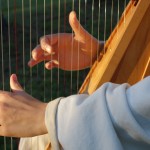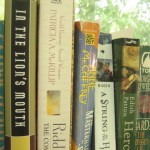And Never The Twain Shall Meet
In Part 1 and Part 2 of my fantasy harp series, I compared harps in fantasy novels with harps in the real world, and at this point you might be thinking, “Well, of course they’re different. These novels are fiction after all and the genre is fantasy.”
You have a point. But I made an interesting realization after reading “On Three Ways of Writing for Children” by fantasy writer C.S. Lewis, in which he discusses the merits of writing and reading fairy tales versus real world stories. In this article, he says,
[The fantastic type of children’s story] is accused of giving children a false impression of the world they live in. But I think no literature that children could read gives them less of a false impression. I think what profess to be realistic stories for children are far more likely to deceive them. “I never expected the real world to be like the fairy tales. I think that I did expect school to be like the school stories. The fantasies did not deceive me: the school stories did. All stories in which children have adventures and successes which are possible, in the sense that they do not break the laws of nature, but almost infinitely improbable, are in more danger than the fairy tales of raising false expectations.”
Later he adds “The dangerous fantasy is always superficially realistic.” After reading this, I understood something. To most readers, stories of harps and their harpers are fantasy: tales with little similarity to their real world. But to me, a story about a harpist affects me more like Lewis’ ‘school stories’ than I would ever have expected. The way an author chooses to describe the harp, its sound, or the process of playing it does often verge on the realistic.  When I sit down to practice everyday, I hold in my arms a beautiful, gilt instrument whose strings, when plucked, produce bell-like tones and whose wild refrain moves listeners to tears. Is it surprising then that I subconsciously begin to compare my ability as a musician with that of harpists in fantasy tales? That I feel like my memory ought to be better, or that the wind ought to at least rustle some leaves in response to my harp’s dulcet strains?
When I sit down to practice everyday, I hold in my arms a beautiful, gilt instrument whose strings, when plucked, produce bell-like tones and whose wild refrain moves listeners to tears. Is it surprising then that I subconsciously begin to compare my ability as a musician with that of harpists in fantasy tales? That I feel like my memory ought to be better, or that the wind ought to at least rustle some leaves in response to my harp’s dulcet strains?
Though I find fantasy portrayals of the harp’s intrinsic magic often exaggerated, I cannot altogether state that this element doesn’t exist in the real world. Michael Flynn introduces his harp with the following description:
It is a clairseach, a lap harp of the old style… draped in a velvet cloth of royal purple and Méarana believes she can hear the strings singing to her. Likely, it is the breath of the air passing through the chords as the butler carries it; but Méarana prefers the poetic to the mundane.”
This happens. When I play at the Renaissance Festival, every so often the sky will turn dark as if in response to the lament that I’m playing, and a breeze will stir up and the harp will start to ring eerily. It’s wonderful to touch the strings and find them already vibrating, and to suddenly discover that the wind is accompanying my song.
 My conclusion is this: a non-musical reader might be charmed and inspired by the enchanted harps of fantasy novels, but a beginning harpist (even a harpist like myself who has played for the greater part of my life) might be tempted to feel discontented with her own abilities. He or she might find that the reality of practicing is much less romantic and interesting than the fantasy.
My conclusion is this: a non-musical reader might be charmed and inspired by the enchanted harps of fantasy novels, but a beginning harpist (even a harpist like myself who has played for the greater part of my life) might be tempted to feel discontented with her own abilities. He or she might find that the reality of practicing is much less romantic and interesting than the fantasy.
C.S. Lewis says one more thing in this article about the child who reads fantasy. I love it. He writes, “[A fantastic story] stirs and troubles him (to his life-long enrichment) with the dim sense of something beyond his reach and, far from dulling or emptying the actual world, gives it a new dimension of depth. He does not despise real woods because he reads of enchanted woods: the reading makes all the real woods a little enchanted.” My recommendation for harpists: keep aspiring to be a better harpist, keep practicing, and keep reading fantasy stories. I’m sure that you will experience those rare moments of real life magic that raise the hairs of your arms and move your listeners and yourself to tears.
Read A Visit to County Antrim, Northern Ireland, by Stephanie Claussen.


